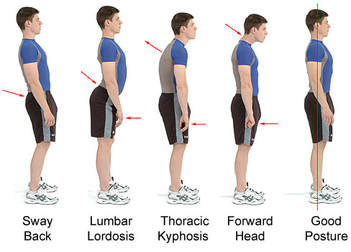|
Firstly - This preconceived idea that we should all fit into some "ideal posture" is ludicrous and needs to stop.
Have you ever heard someone say that your chest is too tight and that you need to train your back muscles more in order to get your shoulders to sit back and to improve your posture? Ever heard the one about weak glutes and tight hip flexors causing your bum to stick out? The common practice where trainers and therapists suggest that a muscle is weak or tight and is causing poor posture is actually negligent and could be considered malpractice. Most postural things you see are not due to weakness or tightness (Tom Purvis, 2015). In addition to this, we certainly cannot tell if a muscle is weak just by looking at someone’s posture. Why wont training a muscle help improve my posture? Training a muscle won’t make you automatically sit in a specific position. Training your back won’t make your shoulders sit back. Training your bicep won’t make your elbow sit at a 90 degree angle. Training your hamstrings won’t make your leg kick backwards. Training your shoulders won’t make your arm sit at a 90 degree angle. Simply strengthening a muscle does not necessarily mean that it will move to a different resting position. It may mean that you have to use less effort to overcome gravity to get to that position you consider as “good posture”. However, it won’t mean you automatically sit in that position. A possibly more effective way to think about posture is that it is all about HABIT and BODY STRUCTURE. Changing your Habits A quick exercise you can do is to simply stand tall and stick your chest out. How do you look? If you can get into a position that you would consider to be “good posture” then maybe you don’t have any muscular weakness or tightness preventing you from being in that position. Maybe you can develop a habit of putting yourself into that position more often over time. If it’s something you want to achieve then it might be a good idea to practice it regularly. In this case it is likely as simple as that. Structural Considerations If you cannot get into a position that you would consider “good posture” then there could be a myriad of things happening that are preventing this. Some of these might include:
Overall, posture is highly individual and will vary greatly between clients. It might not be a good idea to try to jam someone into a posture that their structure simply does not allow for. Instead of always looking to “correct” posture, have a think about what has caused that posture in the first place and whether it actually needs to be changed for that person to function and train effectively. References: Personaltrainingdotcom, 2015, Perspective: “Correcting” Posture (online video) avaiable at: https://www.youtube.com/watch?v=yNWDwE7-cS0&t=357s Delavier, F. (2010). Strength training anatomy. Leeds: Human Kinetics.
1 Comment
4/12/2023 11:27:13 pm
A <a href="https://www.ultraupdates.com/2021/07/best-posture-corrector-guide/">Best Posture Corrector </a> is a device designed to improve one's posture by providing support to the back and shoulders. While it can be helpful for those with poor posture, it should not be relied upon as the sole solution for long-term improvement. Consistent exercise and proper ergonomics are crucial for maintaining good posture.
Reply
Leave a Reply. |
AuthorAlex is a Muscle Activation Techniques Practitioner and Resistance Training Specialist. Focused on Injury Rehab and Maximising Performance. Archives
November 2018
Categories |


 RSS Feed
RSS Feed